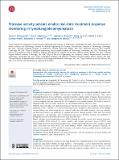Protease activity sensors enable real-time treatment response monitoring in lymphangioleiomyomatosis
Author(s)
Kirkpatrick, Jesse D; Soleimany, Ava P; Dudani, Jaideep S; Liu, Heng-Jia; Lam, Hilaire C; Priolo, Carmen; Henske, Elizabeth P; Bhatia, Sangeeta N; ... Show more Show less
DownloadPublished version (727.3Kb)
Publisher with Creative Commons License
Publisher with Creative Commons License
Creative Commons Attribution
Terms of use
Metadata
Show full item recordAbstract
<jats:sec><jats:title>Background</jats:title><jats:p>Biomarkers of disease progression and treatment response are urgently needed for patients with lymphangioleiomyomatosis (LAM). Activity-based nanosensors, an emerging biosensor class, detect dysregulated proteases <jats:italic>in vivo</jats:italic> and release a reporter to provide a urinary readout of disease. Because proteases are dysregulated in LAM and may directly contribute to lung function decline, activity-based nanosensors may enable quantitative, real-time monitoring of LAM progression and treatment response. We aimed to assess the diagnostic utility of activity-based nanosensors in a pre-clinical model of pulmonary LAM.</jats:p></jats:sec><jats:sec><jats:title>Methods</jats:title><jats:p><jats:italic>Tsc2</jats:italic>-null cells were injected intravenously into female nude mice to establish a mouse model of pulmonary LAM. A library of 14 activity-based nanosensors, designed to detect proteases across multiple catalytic classes, was administered into the lungs of LAM mice and healthy controls, urine was collected, and mass spectrometry was performed to measure nanosensor cleavage products. Mice were then treated with rapamycin and monitored with activity-based nanosensors. Machine learning was performed to distinguish diseased from healthy and treated from untreated mice.</jats:p></jats:sec><jats:sec><jats:title>Results</jats:title><jats:p>Multiple activity-based nanosensors (PP03 (cleaved by metallo, aspartic and cysteine proteases), p<jats:sub>adjusted</jats:sub><0.0001; PP10 (cleaved by serine, aspartic and cysteine proteases), p<jats:sub>adjusted</jats:sub>=0.017)) were differentially cleaved in diseased and healthy lungs, enabling strong classification with a machine learning model (area under the curve (AUC) 0.95 from healthy). Within 2 days after rapamycin initiation, we observed normalisation of PP03 and PP10 cleavage, and machine learning enabled accurate classification of treatment response (AUC 0.94 from untreated).</jats:p></jats:sec><jats:sec><jats:title>Conclusions</jats:title><jats:p>Activity-based nanosensors enable noninvasive, real-time monitoring of disease burden and treatment response in a pre-clinical model of LAM.</jats:p></jats:sec>
Date issued
2021Department
Koch Institute for Integrative Cancer Research at MIT; Harvard University--MIT Division of Health Sciences and Technology; Massachusetts Institute of Technology. Institute for Medical Engineering & Science; Massachusetts Institute of Technology. Department of Biological Engineering; Howard Hughes Medical Institute; Massachusetts Institute of Technology. Department of Electrical Engineering and Computer ScienceJournal
European Respiratory Journal
Publisher
European Respiratory Society (ERS)
Citation
Kirkpatrick, Jesse D, Soleimany, Ava P, Dudani, Jaideep S, Liu, Heng-Jia, Lam, Hilaire C et al. 2021. "Protease activity sensors enable real-time treatment response monitoring in lymphangioleiomyomatosis." European Respiratory Journal, 59 (4).
Version: Final published version